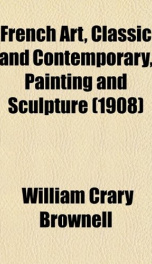French Art

Purchase of this book includes free trial access to www.million-books.com where you can read more than a million books for free. This is an OCR edition with typos. Excerpt from book: did not fully recover for over two hundred years, until, insensibly, it had built up its own traditions and gradually brought about its own inherent development.-1 n a word, French painting had an intellectual rather than an emotional origin. Its first practitioners were men of culture rather than of feeling; they were inspired by the artistic,' the constructive, the fashioning, rather than the poetic, spirit. And so evident is this inclination in even contemporary French paintingand indeed in all French esthetic expressionthat it cannot be ascribed wholly to the circumstances mentioned. The circumstances themselves need an explanation, and find it in the constitution itself of the French mind, which (owing, doubtless, to other circumstances, but that is extraneous) is fundamentally less imaginative and creative than co-ordinating and constructive. Naturally thus, when the Italian influence wore itself out, and the Fontainebleau school gave way to a more purely national art ; when France had definitely entered into her Italian heritage and had learned the lessons that Holland and Flanders had to teach her as well ; when, in fine, the art of the modern world began, it was an art of grammar, of rhetoric. Certainly up to the time of Géricault painting in general held itself rather pedantically aloof from poetry. Claude, Chardin, what may be called the illustrated vers de société of the Louis Quinze paintersof Watteau and Fragonardeven Prudhon, did little to change the prevailing color and tone. Claude's art is, in manner, thoroughly classic. His personal influence was perhaps first felt by Corot. He stands by himself, at any rate, quite apart. He was the first thoroughly original French ? painter, if indeed one may not say he was the first thoroughly original modern ...
Info about the book
Author:
Series:
Unknown
ASIN:
143460747X
Rating:
3.5/5 (5)Your rating:
0/5
Languge:
English
Users who have this book
Users who want this book
What readers are saying
What do you think? Write your own comment on this book!
write a commentif you like French Art try:
Other books by this author
Do you want to read a book that interests you? It’s EASY!
Create an account and send a request for reading to other users on the Webpage of the book!


